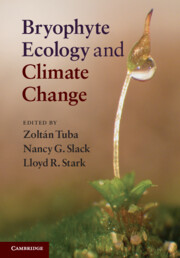Book contents
- Frontmatter
- Contents
- List of contributors
- Preface
- I Introductory Chapters
- II Ecophysiology
- III Aquatic Bryophytes
- IV Desert and Tropical Ecosystems
- V Alpine, Arctic, and Antarctic Ecosystems
- 11 Effects of Climate Change on Tundra Bryophytes
- 12 Alpine Bryophytes as Indicators for Climate Change: a Case Study from the Austrian Alps
- 13 Bryophytes and Lichens in a Changing Climate: An Antarctic Perspective
- VI Sphagnum and Peatlands
- VII Changes in Bryophyte Distribution with Climate Change: Data and Models
- VIII Conclusions
- Index
- References
11 - Effects of Climate Change on Tundra Bryophytes
Published online by Cambridge University Press: 05 October 2012
- Frontmatter
- Contents
- List of contributors
- Preface
- I Introductory Chapters
- II Ecophysiology
- III Aquatic Bryophytes
- IV Desert and Tropical Ecosystems
- V Alpine, Arctic, and Antarctic Ecosystems
- 11 Effects of Climate Change on Tundra Bryophytes
- 12 Alpine Bryophytes as Indicators for Climate Change: a Case Study from the Austrian Alps
- 13 Bryophytes and Lichens in a Changing Climate: An Antarctic Perspective
- VI Sphagnum and Peatlands
- VII Changes in Bryophyte Distribution with Climate Change: Data and Models
- VIII Conclusions
- Index
- References
Summary
Tundra vegetation in the changing climate
In the 1990s global warming was envisioned scientifically as being highly influential and pronounced at high latitudes (Mitchell et al. 1990; Maxwell 1992). Since then, impacts of climate change have been confirmed, especially in the indisputable data of increased air surface temperatures in both the Alaskan Arctic and Europe (Overpeck et al. 1997; Keyser et al. 2000; Serreze et al. 2000; EEA 2004). Ostensibly, climate change is currently affecting life in the world's ecosystems with intensified ramifications of escalating temperatures (IPCC 2007). The Arctic has had a rapid increase in mean temperatures over the past few decades, twice the rate of the rest of the world (ACIA 2005). Its warmest year ever recorded was in 2007 (Richter-Menge et al. 2008). Biomes already seem to be changing owing to climate differences, indicated by observations of enhanced plant growth at high northern latitudes (Myneni et al. 1997) and mid-latitudes (Nemani et al. 2003), landscape-level shifts in species ranges, decline in species populations (McCarthy et al. 2001), and changes in species diversity (EEA 2004). Continuing Arctic climate change will therefore have the effect of encouraging forest expansion into tundra biomes, and the tundra vegetation as we know it will greatly change, shifting in its extent, distribution, and species composition. These changes will probably be unprecedented compared with those of past millennia.
- Type
- Chapter
- Information
- Bryophyte Ecology and Climate Change , pp. 211 - 236Publisher: Cambridge University PressPrint publication year: 2011
References
- 6
- Cited by

